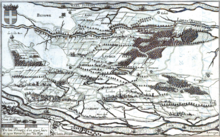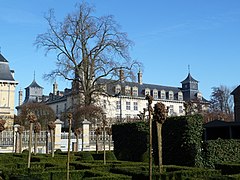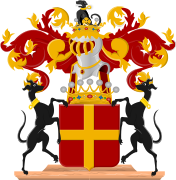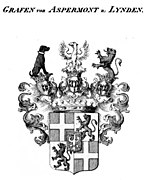Lynden (noble family)
The van Lynden family is an old Gelding noble family. Numerous branches of the family still exist in the Netherlands to this day .
In the 16th century a line was formed, which in 1623 came to the imperial estate in the county of Reckheim and thus to the high nobility . Since 1676 the official title of this line, which has been sitting in what is now Belgium, has been Counts of Aspremont-Lynden . The county of Reckheim was annexed by France in 1795.
history
Originally the family comes from Lienden in the Betuwe countryside in what is now the Netherlands (the Huis ter Lede ancestral castle there was demolished in 1823).
The family consists of several branches. Most of them stayed in the Netherlands and made up several high-ranking military officials, politicians and ministers from the Republic of the Seven United Provinces and the Netherlands.
From 1375 to 1931 the family resided at Hemmen Castle (municipality of Overbetuwe , Gelderland), and temporarily also at Aalst Castle (near Zaltbommel ) and Sinderen (near Voorst ).
Ter Lede Castle in Lynden
Counts of Reckheim and Counts of Aspremont-Lynden
In the 16th century, Thierry de Lynden (Dirk van Lynden) went to the court of the Prince-Bishop of Liège , Erhard von der Mark , married his niece Katharina, later sold his Dutch estates and acquired goods (including Dormaal) in the prince-bishopric. He served its regents as steward and privy councilor. His son Hermann von Lynden (1547–1603) acquired the rule of Reckheim (now Rekem in Belgium) from Wilhelm von Quadt -Wykradt in 1579 , his brother Robert von Lynden (approx. 1535-1610) the rule of Stoumont with Froidcourt Castle. Both were high-ranking military officials. In 1610 they were raised to imperial barons. In 1676 their descendants received the imperial count status under the name Aspremont-Lynden , with reference to an alleged (but based on forgery) descent from the Lorraine counts of Apremont , who had died out in the 14th century and who had carried a similar coat of arms. The county Reckheim belonged since the Lower Rhenish-Westphalian Circle and their owners the Westphalian Count College at.
Reckheim Castle (Rekem) 1626
Aspremont-Lynden Castle in Rekem today
Froidcourt Castle in Stoumont , 1626
This branch provided high-ranking military, politicians and ministers in the Principality of Liège , in the Holy Roman Empire and later in Belgium . Several members of this branch served the Habsburgs and settled in Austria-Hungary , including Field Marshal Count Ferdinand Gobert von Aspremont-Lynden (1645–1708), who received possessions in Hungary through his marriage to Julia Barbara Rákóczi , or his nephew Ferdinand Karl von Aspremont-Lynden (1689–1772), who was also field marshal. Today traces can be found above all in Austria , Slovakia and Hungary, such as the Palais Aspremont in Bratislava and the Palais Erdödy-Fürstenberg in Vienna .
In 1793 the county of Reckheim was occupied by France and annexed in 1795. Count Johann Nepomuk Gobert von Aspremont-Lynden (1732-1805) was compensated with the Baindt Monastery in Württemberg and a pension in 1802 , but in 1812 his son sold the monastery. With his death on September 16, 1819 and only three days later, that of his only son Karl Gobert (1790–1819), the line of the Counts of Reckheim became extinct in the male line. Heiress of the Hungarian estates Lednitz , Ónod , Szerencz, Borsi and Makovicza became Countess Maria von Aspremont-Lynden (1787–1866), daughter of Count Johann Gobert von Aspremont-Lynden (1757–1819), and from 1807 the wife of Count Georg Erdödy ( 1785-1859).
Lednitz Castle, today Lednické Rovne , Slovakia
Borsi Castle, today Borša , Slovakia
Ónod Castle in Hungary, today a ruin
Known members
Branch in the Netherlands
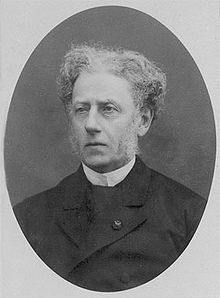
- Frans Godaert van Lynden (1702–1786), 13th lord of Hemmen , Blitterswijk and Lunenburg
- Caspar Anton van Lynden tot de Park (1707–1748), Drost der Heerlijkheid Bredevoort
- Willem Carel Hendrik van Lynden van Blitterswijk (1736–1816), member of the First Chamber of the States General
- Constantia van Lynden van Hoevelaken (1761–1831), mistress of Wilhelm V of Orange-Nassau
- Jan Hendrik van Lynden van Lunenburg (1765–1854), member of the First Chamber of the States General
- Jan Elias Nicolaas van Lynden van Hoevelaken (1766–1841), member and chairman of the Second Chamber of the States General
- Dirk van Lijnden (1779–1837), Mayor of Nijmegen
- Rudolph Willem Graaf van Lynden (1808–1876), Mayor of Apeldoorn , Commissioner of the King of the Province of Zeeland
-
Theo Graaf van Lynden van Sandenburg (1826–1885), Foreign Minister, Finance Minister and Chairman of the Council of Ministers of the Netherlands
- Alex Graaf van Lynden van Sandenburg (1873–1932), Queen's Commissioner in the Province of Utrecht (1914–1924); In this function he was the contact person between Wilhelmina and ex-Kaiser Wilhelm ( Haus Doorn )
- Robert Melvil baron van Lynden (1843–1910), member of the First Chamber of the States General, Foreign Minister
- Alexander Frederik baron van Lynden (1856–1931), Mayor of Utrecht
- Godert Jacob Karel baron van Lynden (1886–1964), Mayor of Baarn , member of the NSB and supporter and advisor to Anton Mussert ; after liberation, he was tried and sentenced to prison
- Godert Alexander Frederik van Lynden (1910–2002), Mayor of Elburg
- Godert Jacob Karel baron van Lynden (1886–1964), Mayor of Baarn , member of the NSB and supporter and advisor to Anton Mussert ; after liberation, he was tried and sentenced to prison
- Constant Theodore Emmo graaf van Lynden van Sandenburg (1905–1990), Commissioner of the Queen in Utrecht
- Frank Wolfaert Boudewijn baron van Lynden (1918–2000), Res. Major of the Cavalry, Coadjutor of the Order of St. John , bearer of the Bronze Cross
Branch in Belgium
- Thierry de Lynden (also Dirk van Lynden) (around 1497–1566), Viscount of Dormaal
- Robert von Lynden (1535–1610), Baron von Froidcourt
-
Hermann von Lynden (1547–1603), purchaser of the Reckheim estate
- Ernst von Lynden (1583–1636), Count of Reckheim
- Ferdinand Gobert von Aspremont-Lynden (1643–1708), Count of Aspremont-Lynden-Reckheim, Imperial Lieutenant Field Marshal
- Ferdinand Karl, Count of Aspremont-Lynden (1689–1772), Imperial Field Marshal
- Wilhelm Josef, Count of Aspremont-Lynden (1702–1779), 1758 Lieutenant Field Marshal
- Guillaume, comte d'Aspremont Lynden (1815–1889), Minister for Foreign Affairs (1871–1878)
- Guy, comte d'Aspremont Lynden de Maillen (1882–1962), lieutenant in the Corps des autos-canons belges (corps of Belgian armored cars with machine guns) in Galicia during the First World War, veteran of both World Wars, Knight of the Order of Malta , recipient of the Order of Leopold II . (Commandeur)
-
Charles, comte d'Aspremont Lynden (1888–1967), Minister of Agriculture (1939–1940), (brother of the previous one)
- Harold, comte d'Aspremont Lynden (1914–1967), 1960/61 Belgian Minister for African Affairs at the time of the Congo crisis
- Geoffroy, comte d'Aspremont Lynden (1904–1979), ambassador
- Jean, comte d'Aspremont Lynden (1926–1944), (killed in combat on September 7, 1944)
Robert von Lynden (1535–1610), Baron von Froidcourt
Hermann von Lynden (1547–1603), purchaser of the Reckheim estate
Ferdinand Gobert von Aspremont-Lynden (1643–1708), Imperial Field Marshal Lieutenant
Ferdinand Karl, Count of Aspremont-Lynden (1689–1772), Imperial Field Marshal
Places related to the family


- Blitterswijck Castle , Netherlands (1515–1788)
- Aspremont-Lynden Castle in Rekem , Belgium (owned by the family from 1579–1792)
- Froidcourt Castle in Stoumont , Belgium (acquired from Robert von Lynden , remained the seat of the older line of the Counts Aspremont-Lynden, Barons von Froidcourt, until around 1792 )
- Barvaux Castle , Belgium (owned by the family from 1680 until today)
- Sandenburg Castle , Netherlands (owned by the family from 1792 until today)
- Haltinne Castle in the municipality of Gesves , Belgium (1814–1889)
- Ry Castle, Mohiville , Belgium (owned by the de Maillen family from 1598 to the present day, d'Aspremont Lynden de Maillen since 1909)
- Mouffrin Castle , Belgium (? (After 1875) until today owned by the family)
- Palais Aspremont in Vienna (end of the 17th century - 1714)
- Aspremont Palace in Bratislava (1769–1781)
- Lednické Rovne Castle in Slovakia (approx. 1756–1819), with its park and the tomb of Johann Nepomuk von Aspremont-Lynden
- Baindt Monastery : In 1802 the monastery was dissolved in the course of secularization and became the property of the Count of Aspremont-Lynden. In 1812, Count Johann Nepomuk Gobert sold Baindt, which in 1806 had been brought under royal Württemberg sovereignty by the Rhenish federal act, to merchants from Ulm.
- coat of arms
See also
- Silverware by Robert von Lynden in the British Museum .
Web links
Individual evidence
- ↑ autorisados à l'ajout de MAILLEN à son nom (26 november 1909)
- ↑ 14-18: Belgian soldiers on the Russian front
- ↑ Memorial plaque of the former students and faculties of the University of Notre-Dame de la Paix (FUNDP) in Namur who died during the two world wars, Namur (name)
- ↑ Lednické Rovne Botanical Park
- ↑ Aspremont-Linden park v Lednických Rovniach ( Memento from May 11, 2015 in the Internet Archive )
- ^ Genealogisches Staats-Handbuch, 66th year, published by Franz Varrentrapp, Frankfurt am Main 1835, p. 384
- ^ British Museum
- ^ British Museum

